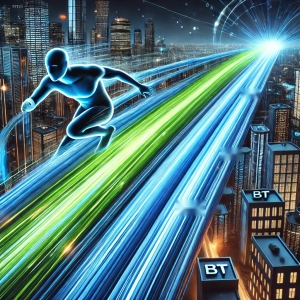Test Owner
Automotive Targeted – But Not in Isolation
It’s been confirmed: the 25% US tariff is specifically aimed at UK-made vehicles, including cars and light trucks.
But there’s more to the story:
- All UK goods entering the US now face a 10% blanket tariff
- Steel and aluminium products — common in containment systems — are also hit with 25% tariffs
- While data cabling itself hasn’t been directly targeted, components within cabling systems and support structures may be affected by rising material costs or changes in supplier priorities
The Role of Data Cabling in Manufacturing — And What’s at Risk
Data cabling plays a pivotal role in manufacturing environments, supporting:
- Machine-to-machine communication and control
- Industrial networking and real-time monitoring
- IoT integration and automation systems
- Power-over-Ethernet for security, access control, and surveillance
As large manufacturers reassess capital expenditure in light of lost export margin, don’t be surprised if some infrastructure upgrades are delayed or rephased — especially where the works are considered enhancements rather than essentials.
What’s Likely to Rise — and Why?
With shifting costs and disrupted supply chains, some price increases are possible — mainly driven by raw material inputs and production adjustments.
What May Rise:
- Steel or aluminium-based containment systems, trays, and brackets
- Bespoke or heavy-duty cable assemblies that include metallic or imported components
- Fixings, enclosures, and accessories where raw input prices are globally indexed
What’s Likely to Stay Stable:
- Standard copper and fibre cabling
- Mainstream accessories and connectors
- Products with strong EU/global competition (where pricing pressure remains)
In some cases, manufacturers may absorb small increases to protect UK market share — but on specialist or metal-intensive items, slight price lifts should be expected.
What Contractors & Consultants Should Do
- Focus on Active Sectors
Prioritise logistics, healthcare, data centres, and other resilient markets — these remain investment-positive.
2. Support Spec Reviews
If a product becomes unavailable or costlier, help clients navigate workable, quality alternatives — especially around containment and accessories.
3. Watch the Manufacturing Sector Closely
Internal projects may stall while export-heavy firms pause and re-plan. But not everything stops — anything tied to uptime, compliance, or safety still moves.
Final Word: Focus, Not Fear
Yes — the 2025 tariffs will reshape some priorities. But the UK's cabling and infrastructure work doesn’t vanish. It shifts. Projects may be delayed, not cancelled. Manufacturers may pause, but logistics, healthcare, energy and data centre sectors continue to invest heavily.
And importantly — let’s not forget — the data cabling industry itself is booming. Demand is being driven by cloud expansion, AI infrastructure, smart warehousing, edge computing, and the ongoing digitisation of everything from hospitals to transport hubs. The backbone of all that? Structured cabling, connectivity, and containment.
So while some sectors recalibrate, others are ramping up — creating plenty of opportunity for those ready to move with the market.
Stay agile. Stay informed. Stay client-focused. That’s how contractors, consultants and suppliers can not only weather this shift — but come out stronger on the other side.
The prospect of two new football stadiums—one for Manchester United and another for Newcastle United—is more than just exciting news for fans. These large-scale infrastructure projects promise to bring thousands of jobs, not just in construction but in key technical industries such as data cabling, networking, and IT infrastructure.
Manchester United’s Plans for a New Super-Stadium
Manchester United has revealed plans to build a 100,000-seat stadium, potentially the largest in the UK. This £2 billion project would replace Old Trafford and form part of a huge regeneration scheme for the local area. It is expected to create:
- 92,000 jobs during construction and beyond.
- 17,000 new homes in the surrounding region.
- An estimated £7.3 billion per year boost to the UK economy.
The stadium itself is set to be a technological masterpiece, featuring a unique “umbrella” canopy and towering masts. However, there have been mixed reports on this design element, with some critics comparing it to Butlin’s holiday camps rather than the sleek, futuristic look many had anticipated.
Despite these differing opinions on aesthetics, the real transformation will be in digital infrastructure, requiring:
- Advanced data cabling for high-speed internet and networking.
- Secure IT networks for ticketing, stadium operations, and broadcasting.
- Smart technology to enhance fan experiences, such as interactive screens, high-speed Wi-Fi, and real-time analytics for crowd management.
These requirements translate into long-term job opportunities for skilled professionals in fibre optic cabling, structured cabling installation, and IT support—both during construction and after the stadium is operational.
Newcastle United’s Proposed Move to a 65,000-Seat Stadium
Newcastle United is also considering moving from St James’ Park to a brand-new 65,000-seater stadium. The potential site? Leazes Park, just north of their current ground. While this move is not confirmed, it is being seriously explored to accommodate Newcastle’s growing fanbase.
If built, this new stadium could:
- Create hundreds of jobs in construction and technology.
- Modernise Newcastle’s infrastructure, with cutting-edge networking and digital systems.
- Enhance the club’s global presence, attracting more international fans and investors.
Newcastle’s new stadium is also expected to feature state-of-the-art technology, including:
- High-performance Wi-Fi networks for tens of thousands of fans.
- Live data streaming for match analytics, fan engagement, and security.
- Smart turnstiles and cashless systems, reducing wait times and improving efficiency.
Just like Manchester’s project, this stadium will demand a workforce skilled in data cabling, telecoms, and networking infrastructure—creating excellent opportunities for engineers, technicians, and IT professionals.
How These Stadiums Will Boost Jobs in Data Cabling & Tech
Both stadium projects will drive demand for skilled workers in the technology sector, particularly in:
✅ Data cabling & fibre optics – Installing high-speed internet, security systems, and broadcasting networks.
✅ IT & networking specialists – Setting up secure digital infrastructure to support stadium operations.
✅ AV & broadcast engineers – Ensuring live-streaming, giant screens, and fan engagement tech function seamlessly.
✅ Cybersecurity experts – Protecting sensitive ticketing and payment systems from cyber threats.
With clubs investing heavily in smart stadium technology, these jobs won’t just be short-term opportunities—there will be long-term maintenance, upgrades, and innovations required in the years to come.
Final Thoughts
The potential new stadiums for Manchester United and Newcastle United represent more than just bigger, better football venues. They are massive investments in technology, infrastructure, and job creation—particularly for skilled workers in data cabling, IT, and smart stadium solutions.
For businesses and professionals in these fields, these projects could mean new contracts, new career opportunities, and a long-term role in shaping the future of UK stadium technology.
Whether you’re an engineer, an IT specialist, or a business in structured cabling, now is the time to gear up for the future of football stadium innovation.
CityFibre, established in 2011, has emerged as a significant challenger to BT's dominance in the UK's broadband sector. With an ambitious £8 billion investment plan, the company aims to disrupt the longstanding monopoly and provide consumers with alternative high-speed internet options.
Strategic Partnerships and Network Expansion
In a notable move, CityFibre secured a partnership with Sky in August 2024, allowing Sky to offer its broadband services over CityFibre's network. This collaboration not only expanded Sky's reach but also underscored CityFibre's growing influence in the market. At that time, CityFibre's network covered approximately 3.8 million premises, with plans to extend this to 8 million in the coming years.
Financial Challenges Amidst Ambitious Goals
Despite its rapid growth and strategic alliances, CityFibre has encountered significant financial hurdles. The company's debt has risen to £4 billion, leading to substantial interest payments. Furthermore, the uptake of its services has been slower than anticipated, with only 518,000 active users out of the 4.3 million premises covered by its network. Analysts suggest that CityFibre needs to double its subscription rate merely to cover interest expenses, highlighting the urgency for increased customer acquisition.
Market Dynamics and Future Outlook
The UK broadband market is witnessing intensified competition, with alternative network providers (altnets) like CityFibre challenging established players such as BT's Openreach and Virgin Media O2. While these altnets have made notable inroads, they face challenges related to profitability and scalability. CityFibre's recent financial performance, achieving an EBITDA of £5 million for the full year 2024, reflects both its progress and the broader challenges within the sector.
In conclusion, CityFibre's endeavour to break BT's broadband monopoly represents a pivotal shift in the UK's telecommunications landscape. However, the company's financial sustainability and ability to achieve widespread consumer adoption remain critical factors that will determine its long-term success.
The construction of Everton’s new stadium is a landmark project that is set to redefine the matchday experience for fans while serving as an architectural and technological marvel in the heart of Liverpool. At Bauhaus, we are proud to have played a key role in this ambitious development by supplying high-calibre data cabling engineers who ensured the successful installation of state-of-the-art infrastructure.
Our Role in the Project
Bauhaus was entrusted with the responsibility of providing expert data cabling engineers to work on Everton’s new stadium. Our team contributed significantly to the installation of critical network infrastructure, ensuring the seamless integration of cutting-edge technology that will power the stadium’s connectivity for years to come.
Key highlights of our involvement include:
- Duration: Over 12 months of consistent effort and collaboration.
- Workforce Supply: More than 20 highly skilled data cabling engineers supplied.
- Scope of Work: Installation of robust data cabling infrastructure, ensuring the stadium meets modern connectivity demands for operations, security, and fan engagement.
Overcoming Challenges
Big projects like this always come with a few hurdles – tight deadlines, complex logistics, and making sure the right people are in the right place at the right time. Our engineers put in serious graft, working 10-hour days to meet high standards while collaborating side by side with other contractors on-site. The result? A solid, future-proofed data cabling setup that will keep Everton’s new home connected – from high-speed Wi-Fi to advanced security systems.
Why Bauhaus?
At Bauhaus, we don’t just fill roles – we find the right people for the job. Our wide network of skilled professionals means we can supply the best talent for big, challenging projects across the UK and Europe. Our work on Everton’s stadium is just one example of how we deliver quality, reliability, and compliance every time.
Looking Ahead
With Everton fans counting down the days until their new stadium opens, we’re proud to know that our work will help power their matchday experience. This project has reinforced our reputation as a trusted recruitment partner in data cabling and technical industries.
We’ve also had the privilege of working on other major stadiums, including White Hart Lane and the Etihad. With our experience in delivering high-quality technical teams for large-scale sports venues, we welcome any future stadium projects that require expert data cabling solutions.
If you’re looking for skilled professionals for your next project – whether it’s data centres, large-scale infrastructure, or commercial builds – Bauhaus is here to help.
Want to know more? Get in touch with us today!
Manchester is poised for a significant transformation with two major developments: the Manchester Digital Campus and the Sister innovation district.
Manchester Digital Campus
Approved by Manchester City Council, the Manchester Digital Campus is set to rise on the former Central Retail Park in Ancoats. This state-of-the-art hub will encompass approximately 900,000 square feet, uniting several Civil Service departments with a focus on digital skills. Designed by AtkinsRéalis, the campus will feature two office buildings, each standing five and six storeys tall. Sustainability is at the forefront, with plans for all-electric power sourced from roof-mounted photovoltaic panels and air-source heat pumps. The development aims for a BREEAM 'Excellent' rating and NABERS 5* certification. Beyond the buildings, the project includes a central lawn and plaza, creating a green buffer to Great Ancoats Street, complemented by tiered gardens and new walking and cycling routes to enhance connectivity. Construction is slated to begin in April 2026, with an estimated build cost of £310 million.
Sister Innovation District
Formerly known as ID Manchester, the Sister innovation district is a £1.7 billion joint venture between The University of Manchester and Bruntwood SciTech. This ambitious project aims to transform the university's former North Campus into a 4 million square foot, globally competitive innovation hub. The latest phase focuses on Zone C, located between London Road and Altrincham Street. Plans include two interconnected buildings, rising 12 and 20 storeys, offering over 500,000 square feet of flexible commercial space. Designed by Allies and Morrison, these structures will house cutting-edge workspaces, leisure areas, and community spaces, all connected by a central atrium. The development also emphasizes the preservation and integration of heritage assets, such as the Grade II-listed Hollaway Wall and viaduct arches, which will be repurposed for retail use. Public consultations are underway to refine these plans, ensuring the district meets the needs of both innovators and the local community.
These projects underscore Manchester's commitment to fostering innovation, sustainability, and economic growth, solidifying its position as a leading hub for technology and industry in the UK.
In a significant shift for the UK contracting market, the government is set to implement changes to the IR35 tax legislation in April 2025, placing the responsibility for determining employment status back into the hands of contractors. While the changes are aimed at simplifying the contracting landscape, the real impact may vary depending on the size of the business. The most notable effect will be on medium-sized companies, particularly those on the cusp of becoming small businesses, as they may find themselves outside of IR35 regulations if they officially transition to small business status. Estimates suggest that around 14,000 companies could be affected by this reclassification.
A medium or large company in the UK is currently defined by meeting at least two of the following criteria:
- Annual Turnover: More than £10.2 million
- Balance Sheet Total: More than £5.1 million
- Number of Employees: More than 50
However, it is important to note that the specific definitions of small, medium, and large companies under the new IR35 rules have not yet been confirmed by the government. There is speculation that these thresholds might change, particularly to ease the administrative burden on smaller businesses, but no official guidance has been released to date.
For large businesses and genuinely small companies, the IR35 changes may not make a significant difference. Large businesses have long-established processes for dealing with IR35 compliance, while small businesses are already exempt from the off-payroll working rules.
What Are the Changes?
The previous IR35 reforms required businesses to assess whether contractors were genuinely self-employed or effectively working as employees, often leading to conservative assessments and increased costs for both parties. The upcoming changes will now allow contractors to decide their own employment status, potentially reducing administrative burdens and restoring autonomy.
What Does This Mean for Contractors?
For contractors, this change is a double-edged sword. On one hand, they gain back control over their tax affairs, which can lead to increased flexibility and potential tax efficiencies. However, with greater control comes greater responsibility. Contractors will need to ensure they are accurately assessing their status to avoid potential tax liabilities or penalties from HMRC.
Impact on Businesses
Businesses are likely to welcome the reduction in compliance burdens and the removal of risks associated with making incorrect IR35 determinations. However, they may still need to exercise caution when engaging with contractors to avoid disputes and ensure clarity in working arrangements.
Expert Opinions
Tax experts have mixed views on the changes. While many believe this move will simplify the contracting landscape, others caution that the risk of misclassification still exists. Professional advice may be essential for both businesses and contractors to navigate these changes effectively.
Conclusion
The 2025 IR35 speculated changes would mark a return to contractor-led assessments, offering more freedom and potentially boosting the contractor market. However, nothing official has been announced yet, and both businesses and contractors should wait for further details from the government. Remaining vigilant and informed will be key to fully benefiting from the new rules while staying compliant with HMRC guidelines. Whether this change will lead to a more dynamic and flexible workforce remains to be seen, but it undoubtedly signals a shift in the government's approach to off-payroll working.
Galliford Try has won a £63m contract to develop Single Living Accommodation (SLA) at RAF Digby, Lincolnshire. This Defence Infrastructure Organisation (DIO) project will deliver modern housing for junior ranks, incorporating energy-efficient and smart building technologies.
Why This Matters for SC Cleared Data Cabling Engineers
- Increased Defence Infrastructure Demand – With large-scale MoD projects underway, secure and high-performance cabling is essential for modern accommodation, security, and communications.
- Smart Building Integration – The development will likely include fibre optic, structured cabling, and network infrastructure to support digital security, surveillance, and IoT-enabled energy systems.
- SC Clearance Advantage – Many military infrastructure projects require Security Cleared (SC) professionals for secure network installations and maintenance.
Potential Roles & Opportunities
- Data Cabling Engineers – Installing and maintaining structured cabling, fibre optic, and copper solutions.
- Network & Infrastructure Technicians – Ensuring secure, high-speed connectivity for military personnel.
- Security & Access Control Specialists – Implementing CCTV, biometric access, and comms systems in line with MoD standards.
With MoD-backed projects prioritising digital infrastructure, SC Cleared data cabling engineers have a strong opportunity to secure long-term work on defence and military developments. Now is the time to position yourself for upcoming contracts.
With US President Donald Trump imposing tariffs on multiple countries, global trade patterns may shift. While these tariffs don’t directly target the UK, they could impact pricing for data cabling and data centres.
Key Impacts on UK Businesses
- Supply Chain Disruptions
- 10% tariffs on Chinese goods could redirect supplies to the UK, potentially lowering prices in the short term due to surplus stock before demand rises again.
- The US is considering tariffs on Vietnam, Indonesia, India, and Taiwan, which may disrupt global sourcing and lead to fluctuating costs for UK importers.
- Taiwan’s semiconductor tariffs could disrupt networking and cabling components for UK businesses.
- Increased competition among suppliers could drive prices down as alternative markets look to attract buyers outside the US.
- Tariffs on Europe & UK Considerations
- Potential US tariffs on European imports may impact UK businesses sourcing from the EU.
- The UK could negotiate separate terms with the US, creating opportunities or challenges.
- Price Volatility – Increases & Decreases Possible
- With tariffs affecting multiple countries, UK importers may struggle to find alternative low-cost suppliers, which could push prices up.
- However, surplus stock from China and supplier competition could lead to price reductions in some cases.
- A universal US tariff system could reshape trade patterns, driving up costs globally, but also creating new pricing dynamics that UK businesses may benefit from.
- Currency Fluctuations
- Trade uncertainty affects GBP/USD exchange rates, impacting import costs. A stronger GBP could offset some price increases, while a weaker GBP may add to them.
How UK Businesses Can Prepare
- Plan Ahead: Budget for potential price increases but also take advantage of potential price drops where possible.
- Explore Alternative Suppliers: Evaluate domestic and Commonwealth sourcing (India, Canada, Australia) while monitoring shifting trade dynamics.
- Monitor Trends: Stay updated on trade policies, surplus stock movements, and currency shifts.
- Assess Semiconductor Dependencies: Secure alternative suppliers for networking components.
Final Thoughts
With tariffs affecting multiple countries, UK businesses should anticipate both cost increases and potential price reductions depending on supply chain shifts. Strategic planning, supplier diversification, and risk management will be essential for long-term stability.
The recent announcement of increased National Insurance (NI) contributions in the UK has sparked widespread discussions across various industries. The data cabling market, already navigating challenges such as fluctuating demand and supply chain issues, now faces another factor that could significantly impact hiring decisions, redundancies, and overall business spending.
This blog explores how these changes might influence the sector and provides a financial analysis of how different company sizes may feel the effects.
What Are the Changes?
The UK government has increased NI contributions, affecting both employers and employees. Employers now pay higher NI rates for their staff, which directly increases payroll costs. This change, though aimed at funding essential public services, places additional financial strain on businesses—particularly those in labour-intensive industries like data cabling.
Key Considerations for the Data Cabling Market
- Hiring Permanent Staff vs. Contractors
Data cabling businesses often operate with a mix of permanent staff and contractors. Higher NI costs might discourage companies from hiring new permanent employees, pushing them to rely more heavily on contractors. While contractors do not incur direct NI costs for the employer, they often charge higher day rates, potentially offsetting any savings. - Redundancies or Reduced Job Opportunities
For companies already operating on tight margins, the increased NI costs could lead to redundancies or the decision not to replace departing staff. This might strain existing teams and affect service quality or delivery timelines. - Reduced Spending and Liquidity Focus
Businesses may choose to limit their spending on non-essential projects or delay expansion plans. Prioritising liquidity over growth could mean fewer large-scale data cabling projects being commissioned. - Impact on Smaller Firms
Small and medium-sized enterprises (SMEs) in the sector could feel the brunt of these changes. For companies with limited resources, increased payroll taxes might erode profitability, making it harder to compete with larger firms.
Financial Impact: A Company-Level Analysis
Below is a calculation of the financial impact of increased NI contributions on businesses with varying staff sizes. Let’s assume:
- An average salary of £35,000 per year.
- The employer NI rate has increased by 1.25 percentage points.
- The previous employer NI contribution rate was 13.8%.
Cost Analysis
- 50 Employees
- Pre-increase NI cost per employee: £4,830
- Post-increase NI cost per employee: £5,265
- Annual NI cost increase per employee: £435
- Total annual increase for 50 employees: £21,750
- 100 Employees
- Annual NI cost increase per employee: £435
- Total annual increase for 100 employees: £43,500
- 250 Employees
- Annual NI cost increase per employee: £435
- Total annual increase for 250 employees: £108,750
- 500 Employees
- Annual NI cost increase per employee: £435
- Total annual increase for 400 employees: £217,500
Potential Outcomes for the Data Cabling Market
- Delayed Projects:
Companies may avoid taking on long-term or large-scale data cabling jobs that require upfront investment and extensive labour resources. - Shift to Outsourcing:
To minimise fixed costs, businesses might increasingly outsource installation or maintenance work to contractors or specialist firms. - Innovation in Efficiency:
The pressure to manage costs could drive companies to invest in more efficient tools, technologies, and processes to offset rising labour costs. - Market Consolidation:
Smaller firms may find it harder to absorb the increased costs, potentially leading to consolidation in the market as larger firms acquire struggling competitors.
Conclusion
The NI increases represent an additional financial burden for businesses in the data cabling market. While larger companies, with their robust financial health, may be better suited to absorb these costs without significant disruption, they often employ a larger workforce and may face pressure to improve margins to offset the impact. Smaller companies, though typically operating with leaner teams, might also be able to stomach these increases by managing costs more tightly and leveraging their agility to adapt quickly to financial challenges. The exact impact will vary by organisation size and business model, but the trend is clear: the need to balance cost efficiency with operational effectiveness will be more critical than ever.
The UK government has unveiled a bold new strategy to position the country as a global leader in artificial intelligence (AI). Central to this blueprint is the transformative role of data centres, which are the backbone of AI development and deployment. By investing in AI and its infrastructure, this plan has profound implications for the tech industry and its stakeholders.
A Focus on Data Centres
Data centres are at the heart of the AI revolution. The UK’s blueprint recognises their critical role in:
- AI Training and Deployment: Supporting the massive computational demands of machine learning models.
- Data Storage and Processing: Ensuring secure and efficient management of the vast datasets required for AI advancements.
- Sustainability Initiatives: Promoting energy-efficient and eco-friendly data centre operations to align with green goals.
Key Industry Impacts
- Expansion of Data Centre Infrastructure
The government’s plan includes:
- Encouraging investments in state-of-the-art data centre facilities.
- Providing incentives for companies to upgrade their infrastructure to handle AI workloads.
- Supporting innovation in cooling and energy technologies to reduce carbon footprints.
- Increased Collaboration
Public-private partnerships will play a significant role in enhancing data centre capabilities. This includes:
- Collaboration with tech firms to integrate cutting-edge AI tools.
- Joint initiatives to create scalable and secure data storage solutions.
- Job Creation and Skill Development
The emphasis on data centres is expected to:
- Generate new opportunities for IT professionals, engineers, and technicians.
- Spur demand for specialised skills in AI system management and data infrastructure.
- Offer training programs to upskill workers in emerging technologies.
Challenges and Opportunities
While the focus on data centres is promising, challenges like energy consumption, data security, and infrastructure scalability remain. To address these, the government plans to:
- Invest in renewable energy solutions for data centres.
- Establish regulations to ensure data integrity and privacy.
- Foster innovation to meet the growing demands of AI applications.
Shaping the Future
This blueprint underscores the pivotal role of data centres in the AI ecosystem. By driving investment and innovation in this sector, the UK aims to create a more robust, efficient, and sustainable foundation for AI technologies. As the strategy unfolds, it will reshape the tech industry, offering new opportunities and addressing critical challenges.












